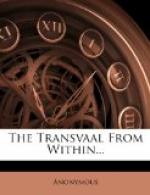CHAPTER VIII.
ARREST AND TRIAL OF THE REFORMERS.
About half of the members of the Reform Committee were arrested and taken through to Pretoria on the night of the 9th. Others were arrested at various times during the evening and night, were detained in the lock-up at Johannesburg as ordinary felons, and escorted to the Pretoria gaol on the following morning. The scene on their arrival at Pretoria railway station and during their march to the gaol was not creditable to the Boers. A howling mob surrounded the prisoners, hustling them, striking them, and hurling abuse at them incessantly. The mounted burghers acting as an escort forced their horses at the unfortunate men on foot, jostling them and threatening to ride them down. One of the prisoners, a man close on sixty years of age, was thrown by an excited patriot and kicked and trampled on before he was rescued by some of his comrades.
Once within the gaol, the men were searched and locked up in the cells, and treated exactly as black or white felons of the lowest description. In many cases four or five men were incarcerated in single cells 9 feet long by 5 feet 6 inches wide, with one small grating for ventilation. At night they were obliged to lie on the mud floor, or in some cases on filthy straw mattresses left in the cells by former occupants. No provision was made by which they could obtain blankets or other covering—indeed at first it was not necessary, as the overcrowding and lack of ventilation




